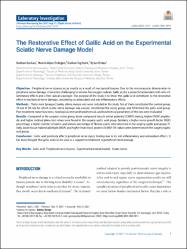| dc.contributor.author | Gürkan, Gökhan | |
| dc.contributor.author | Erdoğan, Mümin Alper | |
| dc.contributor.author | Yiğittürk, Gürkan | |
| dc.contributor.author | Erbaş, Oytun | |
| dc.date.accessioned | 2021-08-17T08:21:13Z | |
| dc.date.available | 2021-08-17T08:21:13Z | |
| dc.date.issued | 2021 | en_US |
| dc.identifier.citation | Gurkan G, Erdogan MA, Yigitturk G, Erbas O. The Restorative Effect of Gallic Acid on the Experimental Sciatic Nerve Damage Model. J Korean Neurosurg Soc. 2021 Aug 11. doi: 10.3340/jkns.2021.0078. Epub ahead of print. PMID: 34376039. | en_US |
| dc.identifier.issn | 2005-3711 | |
| dc.identifier.issn | 1598-7876 | |
| dc.identifier.uri | https://doi.org/10.3340/jkns.2021.0078 | |
| dc.identifier.uri | https://hdl.handle.net/20.500.12809/9481 | |
| dc.description.abstract | Objective: Peripheral nerve injuries occur mostly as a result of mechanical trauma. Due to the microvascular deterioration in peripheral nerve damage, it becomes challenging to remove free oxygen radicals. Gallic acid is a powerful antioxidant with anti-inflammatory effects and a free radical scavenger. The purpose of the study is to show that gallic acid contributes to the restorative effect in mechanical nerve damage, considering its antioxidant and anti-inflammatory effects.
Methods: Thirty male Sprague Dawley albino mature rats were included in the study. Ten of them constituted the control group, 10 out of 20 rats for which sciatic nerve damage was caused, constituted the saline group, and 10 formed the gallic acid group. Post-treatment motor functions, histological, immunohistochemical, and biochemical parameters of the rats were evaluated.
Results: Compared to the surgery+saline group, lower compound muscle action potential (CMAP) latency, higher CMAP amplitude, and higher inclined plane test values were found in the surgery+gallic acid group. Similarly, a higher nerve growth factor (NGF) percentage, a higher number of axons, and a lower percentage of fibrosis scores were observed in the surgery+gallic acid group. Finally, lower tissue malondialdehyde (MDA) and higher heat shock protein-70 (HSP-70) values were determined in the surgery+gallic acid group.
Conclusion: Gallic acid positively affects peripheral nerve injury healing due to its anti-inflammatory and antioxidant effects. It has been thought that gallic acid can be used as a supportive treatment in peripheral nerve damage. | en_US |
| dc.item-language.iso | eng | en_US |
| dc.publisher | Korean Neurosurgical Society | en_US |
| dc.relation.isversionof | 10.3340/jkns.2021.0078 | en_US |
| dc.item-rights | info:eu-repo/semantics/openAccess | en_US |
| dc.subject | Gallic acid | en_US |
| dc.subject | Peripheral nerve injuries | en_US |
| dc.subject | Experimental animal models | en_US |
| dc.subject | Sciatic nerve | en_US |
| dc.title | The Restorative Effect of Gallic Acid on the Experimental Sciatic Nerve Damage Model | en_US |
| dc.item-type | article | en_US |
| dc.contributor.department | MÜ, Tıp Fakültesi, Temel Tıp Bilimleri Bölümü | en_US |
| dc.contributor.authorID | 0000-0002-5315-253X | en_US |
| dc.contributor.institutionauthor | Yiğittürk, Gürkan | |
| dc.relation.journal | Journal of Korean Neurosurgical Society | en_US |
| dc.relation.publicationcategory | Makale - Uluslararası Hakemli Dergi - Kurum Öğretim Elemanı | en_US |


















